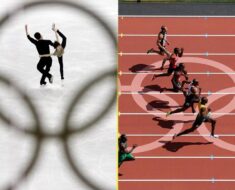Definition of injury
“Unintentional or intentional damage to the body resulting from acute exposure to thermal, mechanical, electrical, or chemical energy, or the absence of essential elements such as heat or oxygen.”
Causal factors of sports injuries:
intrinsic factors
Age
Gender
body size
injury history
Training level
Muscle strength/flexibility
skill level
psychological state
extrinsic factors
Equipment
Atmosphere
Type of activity
conditioning errors
What is injury prevention?
Injuries can be prevented by changing the environment, individual behavior, products, social norms, legislation, and government and institutional policies to reduce or eliminate risks and increase protective factors.
Primary and secondary prevention:
Primary prevention is the prevention of the appearance of lesions.
Secondary prevention is the prevention of recurrence of lesions.
There are a number of factors responsible for injury prevention. They are:
1. Warm-up, 2. Stretching, 3. Wraps and braces, 4. Protective equipment, 5. Correct biomechanics, 6. Proper equipment, 7. Appropriate surfaces, 8. Proper training, 9. Proper recovery, 10. Psychology
11. Nutrition
1. Warm-up:
The literary meaning of warm-up is to raise the core body temperature. The warm-up is further classified into general and sports-specific warm-ups.
The benefits of heating include:
1. Increased blood flow to muscles
2. Reduced muscle viscosity causing smooth muscle contractions
3. Improvement of the mechanical efficiency of the muscle.
4. Favorable neuro-myoconductance
5. Favorable changes in muscle receptors that decrease muscle sensitivity to stretch.
6. Improved cardiovascular compatibility
7. Improved mental concentration for sports activities.
How warming up helps prevent injuries:
1. Increase Preheat ROM
2. Decrease the stiffness of connective tissue; this further leads to higher forces and stretch length required for a tear to occur.
2. Stretch:
The ability to move joints smoothly through a full ROM is an important component of good health.
The basic principles of stretching are:
1. Warm up before stretching
2. Stretch before and after exercise/sport
3. Stretch gently and slowly
4. Stretch to the point of tension but not to the point of pain
How Stretching Helps In Injury Prevention:
There is considerable research evidence to say;
Increasing flexibility through stretching seems to result in a lower incidence of musculoskeletal injuries, minimizing and relieving muscle pain. Further stretching can improve athletic performance.
3. Taping and bracing:
Tapes and gussets are used to restrict unrestricted, potentially harmful movement and allow for desired movement. There are two main indicators for the use of tapes and braces:
1. prevention- of the two procedures mentioned, taping is used as a preventive measure for high-risk activities. For example, bandages on the ankles of basketball players.
2. Rehabilitation: the bandage is used as a protection mechanism during the healing and rehabilitation phase.
4. Protective equipment:
Protective gear protects various vital parts of the body from injury. Most importantly, protective equipment should not interfere with sports activities.
5. Correct biomechanics:
Correct biomechanics are an important factor in achieving maximum efficiency of movement and in preventing injuries. Faulty biomechanics can be due to static (anatomical) abnormalities or dynamic (functional) abnormalities.
Examples:
Static abnormalities: LLD, Genu valgum, pronated calcaneus
Dynamic abnormalities: running with excessive anterior pelvic tilt.
What happens when there is altered biomechanics?
Bad techniques are the result of inadequate biomechanics. This poor technique results in not only injury but also reduced performance.
6. Suitable equipment:
The equipment can vary from simple to complex.
Example of simple equipment is sports shoes.
Examples of complex equipment are; rackets, clubs, bicycles, motor vehicles, etc.
According to Khan & Brukner, the top 3 injury producers are: shoes, rackets, and bicycles.
Parts of a sports shoe: heel counter, toe, midsole.
Racket parts: grip, shaft and racket head
Important parts of a bike from a sporting angle: saddle height, saddle position, handlebar mount position. Pedaling technique is one of the most important aspects where injuries can be prevented.
7. Suitable surface:
When walking and running, the body is subjected to highly repetitive and short-lived forces, increasing susceptibility to injury. The maximum impact forces in walking, running and jumping have been shown to approach 2 times, 3-4 times, 5-12 times respectively.
The surfaces alter the maximum force to which the body is subjected during activity. The maximum impact forces are much higher on hard surfaces than on soft ones. Therefore, softer surfaces reduce the chances of sports injuries.
8. Proper training:
Training errors are the most common predisposing factors in the development of sports injuries.
Training is a constant balance between doing enough quality and quantity of work to maximize performance, but not so much that injury occurs.
The full explanation of training is beyond the scope of this discussion.
In a nutshell:
The principles of training are:
1. periodization
2. specificity
3. overload
4. individuality
The different training methods involve:
1. Aerobic training or resistance training
2. anaerobic training or lactate training
3. Strength and Power Training
4. Flexibility Training
5. Speed and Agility Training
7. Specific skills training
8. Cross Training
9. Proper recovery:
Proper recovery is essential if the full effect of training is to be obtained and injury is to be prevented.
“Ranging Over” – Inadequate recovery leads to poor performance and associated symptoms such as tiredness and lethargy, referred to as “Ranging Over”. If you continue training from this moment on, injuries may occur. However, athletes often respond to such symptoms with increased training, which they perceive as “unfit.” This leads to what is called “overtraining syndrome.” Therefore, it is important that the coach closely monitors the training program.
Proper recovery includes:
1. warm-ups
2. whirlpools and spas
3. massage
4. rest and sleep
5. psychological and nutritional advice
10. Psychology and injury prevention:
excessive arousal:
The detrimental effect of excessive psychological arousal is a well-recognized entity. Excessive psychological arousal predisposes the athlete to injury.
Excessive excitement leads to altered muscle tension. This further leads to upsetting the fine balance between agonist and antagonist, which is the hallmark of quality performance. Once this synergy between agonist and antagonist is lost; a modified technique is used instead of the natural technique. There is also “Loss of Rhythm”. This factor predisposes to injury.
Excessive excitement also leads to loss of mental concentration. Consequently, the feet and the body are not placed in the proper position on the sports field. Therefore, the player is placed in a biomechanically poor position to play return shots. This predisposes to injury.
Excessive arousal leads to a “narrow focus of attention”; therefore, he fails to read the work. This can result in them being easily tackled or hit from the “blind side”.
“White Line Fever” – This is another example of overexcitement. Here the athlete loses all perception of danger when going out onto the field. Consequently, he places his body in positions vulnerable to injury.
Overexcited players enter a competition without proper nutrition. This further leads the individual to sports injuries.
Low arousal: less common variety. Test or lower level competition matches occur.
The less excited athlete shows the following:
1. Impaired reading of visual cues.
2. Slow decision making.
3. Do not take appropriate evasive measures.
4. Make technical mistakes.
These above-mentioned points are responsible for sports injuries in under-excited athletes.
11. Nutrition and injury prevention:
1. Proper nutrition can indirectly lead to injury through its effect on the recovery process.
2. By continuous intense training; labile muscle proteins are channeled into gluconeogenesis to produce energy. Therefore, protein deficiency in the diet can lead to damage to the soft tissues of the muscles.
3. Inadequate hydration has an immediate and acute impact on athletic performance, especially when exercising under thermal conditions.
4. Minerals such as calcium have a very important role to play in the physiology of muscle contraction. Increased exercise builds on the body’s calcium stores. Inadequate calcium intake weakens the bone and can lead to fractures. electrolyte balance; in addition, the internal environment is maintained by sodium and potassium. The deficiency of these minerals leads to serious metabolic disturbances. They can even cause death.
5. Low calorie diet can lead to decrease in fat ratio to the point that women miss the monthly period. This further leads to osteoporosis and fractures.





